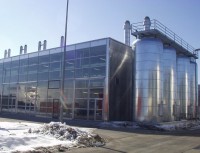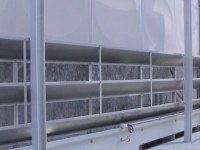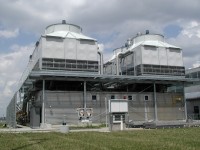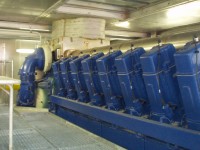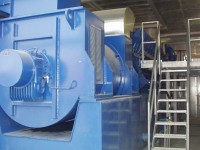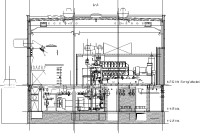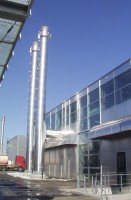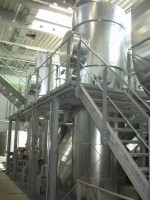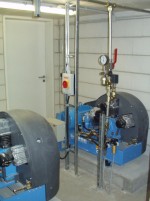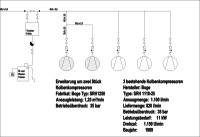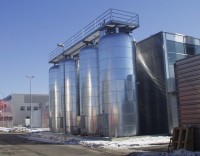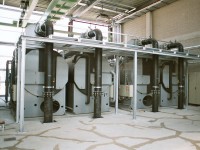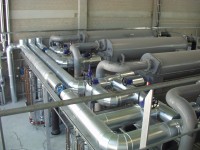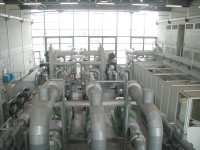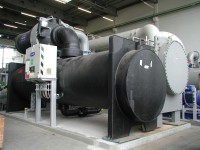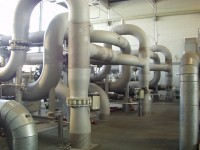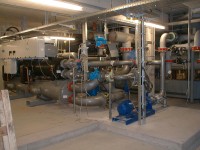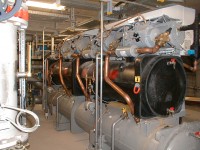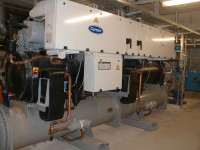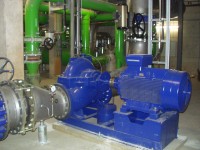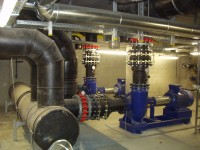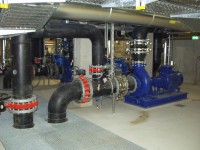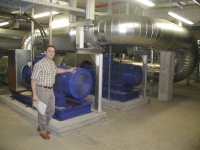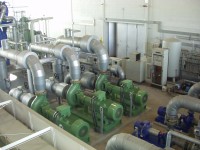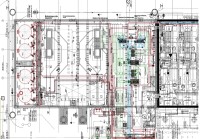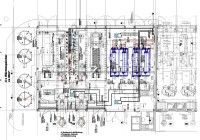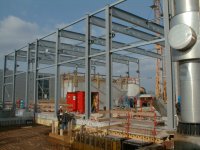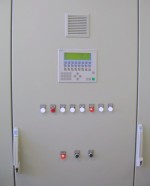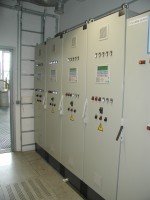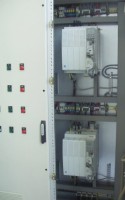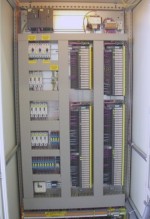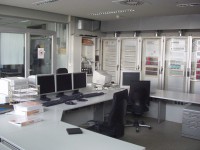Extension of the supply station ("Versorgungszentrale")
Munich Airport Franz Josef Strauss
You may also get informed about our experience with
Would you like to get to know more about us?
Please have a look at our company profile, our services and feel free to get in contact with us.
Table of content
Project data
| Planning and realisation period: | 1999 .. 2003 |
| Start of operations: | May 2003 |
| Project size: | appx. 13 Mio. € in total |
| Client: | Flughafen Muenchen GmbH |
Contractor
Engineering consortium Erweiterung Versorgungszentrale (IGVZ):
| Ingenieurbuero W. Roegelein, VBI, Muenchen | Planning and site management of heating and cooling facilities including automation facilities. |
| Regierungsbaumeister Schlegel GmbH&Co. KG, Muenchen | Procuration of the consortium |
Tasks/Basics
- User requirements for the extension of combined heat, cooling and power (CHCP) and installation of electrical refrigerators in the supply station 145.0 for energy supply of the Terminal 2. Compiled by the Projektteam Terminal 2 on May 17th, 1999.
- Study "Energy concept Munich airport" of the ZAY Bayern and Ingenieurbuero W. Roegelein, VBI as of April, 1996.
- Work phases 2 .. 8 according to HOAI Part 9 § 73
Engineering tasks
Industrial engineering for combined heat, cooling and power generation:
- Blueprint and preliminary planning
- Application for approval
- Planning of the implementation phase
- Tender in multiple project units
- Site management
Project characteristics
The Flughafen Muenchen GmbH extends the supply station 145.0 in order to supply Terminal 2 and luggage sorting facility with district heating and cooling.
The district cooling load of Terminal 2 is being covered by the supply station by 12,0 MW.
This additional demand is covered by exchanging the three existing turbo refrigerators with four
electrical compression refrigerators (R134a) with about double power one the one hand, and by additional
absorption refrigerators on the other hand.
The existing wet cooling towers, provisioned to dissipate the heat from the refrigerators' condensers and for emergency cooling of the block heat and power plant's engines, will be extended by 60% as well.
The block heat and power plant will be extended with two Gas-Otto engines, heat emission of 9,6 MW each, capable of transferring heat to the hot water circuit (tmax=140°C, PN 16):
- electrical nominal power 3.700 kW each
- thermical engine power
- Cooling water, lubricating oil and mixture chiller circuit (heating water temperature level 60°C/90°C) 2.050 kW each
- Heat recovery boiler, group IV Dampf-KV, BoB 604/2 (exhaust fumes temperature 500°C/120°C, heating water temperature level 80°C/130°C PN 16) 2.550 kW each
- Extension of the compressed air supply with two piston compressors for generating the starting air for the Gas-Diesel engines (inventory) and the new Gas-Otto engines
By extending the block heat and power facility also an augmentation of the heat reservoirs by 4 x 90 m3 as well as a hydraulic integration with the existing system has become a necessity.
Primary energetic advantages of the CHCP concept
A comparison on the primary energetic level highlights that the combined heat, cooling and power technology applied at Munich Airport in combination with absorption refrigeration leads with regard to the made assumptions to a reduced consumption of 13,3% of primary energy in comparison to installing compression refrigerators with identical cooling quantity. It was assumed that electrical power for the compression refrigerators and the auxiliary engines would be acquired from the energy supply company.
The efficiency of the combined heat, cooling and power system installed at Munich Airport is determined significantly by the high electrical degree of utilisation of the block heat and power plant, so that disadvantages of thermical refrigeration become compensated while significant primary energetic advantages that lead to a reduction of CO2 emission can be realized.
Extension of the cooling generation
- 4 absorption refrigerators in two groups, obtaining their thermical operating power from the heat extraction
of the block heat and power plant.
Two absorption refrigerators are connected in serial on the thermical power and cold water side, respectively.
The cooling power of each absorption refrigerator group is at Q0=2.650 kW.
Heating water is being cooled down from 130°C to 70°C.
- 3 turbo refrigerators (water-cooled)
Cooling power Q0=5.750 kW each
Qcompressor=909 kW
Refrigerant R134a
- 1 Schrauben-Kaelteverdichter (?) (water-cooled)
Cooling power Q0=1.250 kW
Qcompressor=232 kW
Refrigerant R134a
The Schraubenkaeltemaschine (?) can also be applied in combination with free cooling.
- 1 cooling water surge pump
V'=2.150 m3/h, H=1,5 bar
Operating power 160 kW
- 2 cooling water surge pumps
V'=1.300 m3/h, H=1,8 bar
Operating power 90 kW
- 2 cooling water pumps for absorption refrigerators
V'=950 m3/h, H=1,8 bar
Operating power 90 kW
- 2 cold water revolution pumps
V'=1.300 m3/h, H=4,6 bar
Operating power 300 kW - 1 cold water revolution pump
V'=1.400 m3/h, H=4,2 bar
Operating power 240 kW
Constructional extensions
In order to extend the block heat and power facility for the new absorption refrigerators, a new building
with cellar is added and connected in the north to the existing supply station, resembling its appearance.
This appendix is of the dimensions 35,6m x 19,7m.
Automation systems
On the automation layer programmable logic controllers (PLC) S7 and S5 are applied for new systems and extending existing systems respectively.
The automation system posseses provisions for manual control of actors in the field and in the switchboards.
On the automation layer application software for overlayed control by S7 and for changing and enhancing existing S5 controls (Siemens Siclimat) is applied.
The new block heat and power engines 8+9 have an overlayed PLC S7 for heat and power driven operation.
With heat driven operation the block heat and power engines 8+9 become switched on and off dependant on the
load state of the heat reservoirs.
The power driven state which has precedence over the heat driven state is realized in combination with a reqeust signal from the control system.
The refrigerators, which are 3 new turbo refrigerators TKM 1..3, one Schraubenkaeltemaschine SKM 1, two existing absorption refrigerators (single effect) AKM 1 and 2, one existing absorption refrigerator (single effect double lift) AKM 3 as well as the new absorption refrigerators AKM 4 and 5 (two groups with two engines respectively) are equipped with PLC engine controls.
The refrigerators can be operated manually on location or via the overlayed management layer.
The refrigerators' sequenced actuation is realized load-dependant by the overlayed management system with regard to different factors (pressure difference on the vaporizer circuit, cold water network temperature, availability).
The cold water network supply temperature of the district cooling network can be controlled continuously from 5°C to 9°C dependant on climate conditions.
Controlling the heating water network
The extracted heat from the two block heat and power subsystems (engines 1..7, engines 8,9) satisfies the base load
of the district heating network as well as of the absorption refrigerators.
Heat extraction for the district heating network is realized on two temperature levels
- at the head of the heat reservoirs
- via an intermediary extraction
Cooling water supply
As a result of the extension of the block heat and power plant with engines 8 and 9 and the AKM groups 4 and 5 the cooling tower performance had to be extended from 24 MW to about 60 MW. Therefor the automation and control system has to cope with the following functional areas additionally:
- Control of two frequency controlled cooling water surge pumps including the pump throttle plates for absorption refrigerators 4 and 5 as well as for the emergency and composite air cooling of the block heat and power engines 8 and 9
- Control of one additional cooling water surge pump inclunding pump throttle plates for the electrical compression refrigerator and for charge air cooling of block heat and power engines 1 to 7.
Extension and modification of the enhanced cooling towers' control system for a total of 10 cooling towers which are controlled dependant on load and the calculated cooling zone size.
Management layer
For the automation system a management layer has been installed in the supply station, including several operation possibilities:
- Primary control unit
- Engineering station
- Data storage station
- Remote operation via notebooks
The various stations are integrated and connected to the existing management system via ethernet networks.
